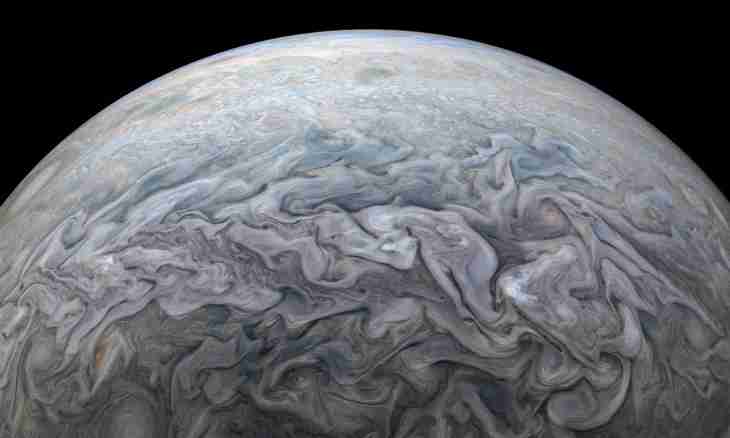Floodlight is the largest and massive planet of the Solar system. It can be observed from Earth by means of the telescope with increase in everything in several dozen times.
Atmosphere
The atmosphere of Jupiter approximately for 90% consists of hydrogen, the rest is the share of helium. At it there are also very insignificant impurity of other gases – methane, ammonia, ethane, acetylene, water vapor.
In the top layers the light strips of plumose clouds consisting of ammoniac crystals are noticeable. At a temperature of-145 wasps they swim in the atmosphere of Jupiter. Where they are not, several dozen kilometers below, it is possible to observe the color clouds consisting of mix of sulfur and ammonia. Even lower, in process of temperature increase and pressure, at the atmosphere of Jupiter there is water in the form of crystals of ice and droplets.
Because of heat coming to the lower layers of the atmosphere of the planet, the mass of clouds and gases are in the constant movement. Winds blow with a speed several kilometers per hour. In this part of the atmosphere whole gales, like terrestrial cyclones and anti-cyclones are formed.
Temperature and pressure increase in process of advance in deeper layers of the atmosphere of Jupiter. Under color clouds of a condition approach terrestrial indicators. Temperature keeps within 10-20 wasps, and pressure is about 1 bar.
Relief
On Jupiter there is no firm surface. Therefore, there is no relief also. Heat from depths of Jupiter is taken out by convection which generates turbulent whirlwinds.
Day and year
Day on Jupiter lasts 10 hours. So much time is required to the planet to make a whole revolution around an axis. And here year on Jupiter proceeds 12 terrestrial years.
Satellites
67 natural satellites of Jupiter are known. The first four were opened in the 17th century by Galilei. They received names: Io, Europe, Ganymede, Callisto. All of them are turned to Jupiter by the same party.
The Io satellite is wrapped around the planet in 42 hours. It is to Jupiter slightly closer, than to the Moon to Earth. To Io the rough volcanic activity proceeds.
Europe – the smallest of the satellites opened by Galilei. He turns around around Jupiter in 85 hours. Its surface is covered with an ice armor.
Ganymede – the largest satellite of the planet. It makes a whole revolution around Jupiter in 7.2 days. Its surface reminds an ancient landscape. In places ice looks out.
Callisto does a whole revolution around Jupiter in 16.7 days. Its surface is noted by numerous blows of comets and asteroids.All other satellites too small therefore Galilei could not see them. Possibly, it is the former asteroids taken by gravitation of Jupiter. One of small satellites, it seems, broke up into pieces therefore Jupiter is surrounded with a thin ring of dust.

